Karen Shares How She Got Started, Why She Wrote A Book, And Offers Practical Tips For Improving Your Chainmaille Technique
Disclosure: Some of the links to products below are affiliate links, meaning, at no cost to you, I may earn a commission if you click through and make a purchase. It helps me create content like this for you, and I thank you for your support.
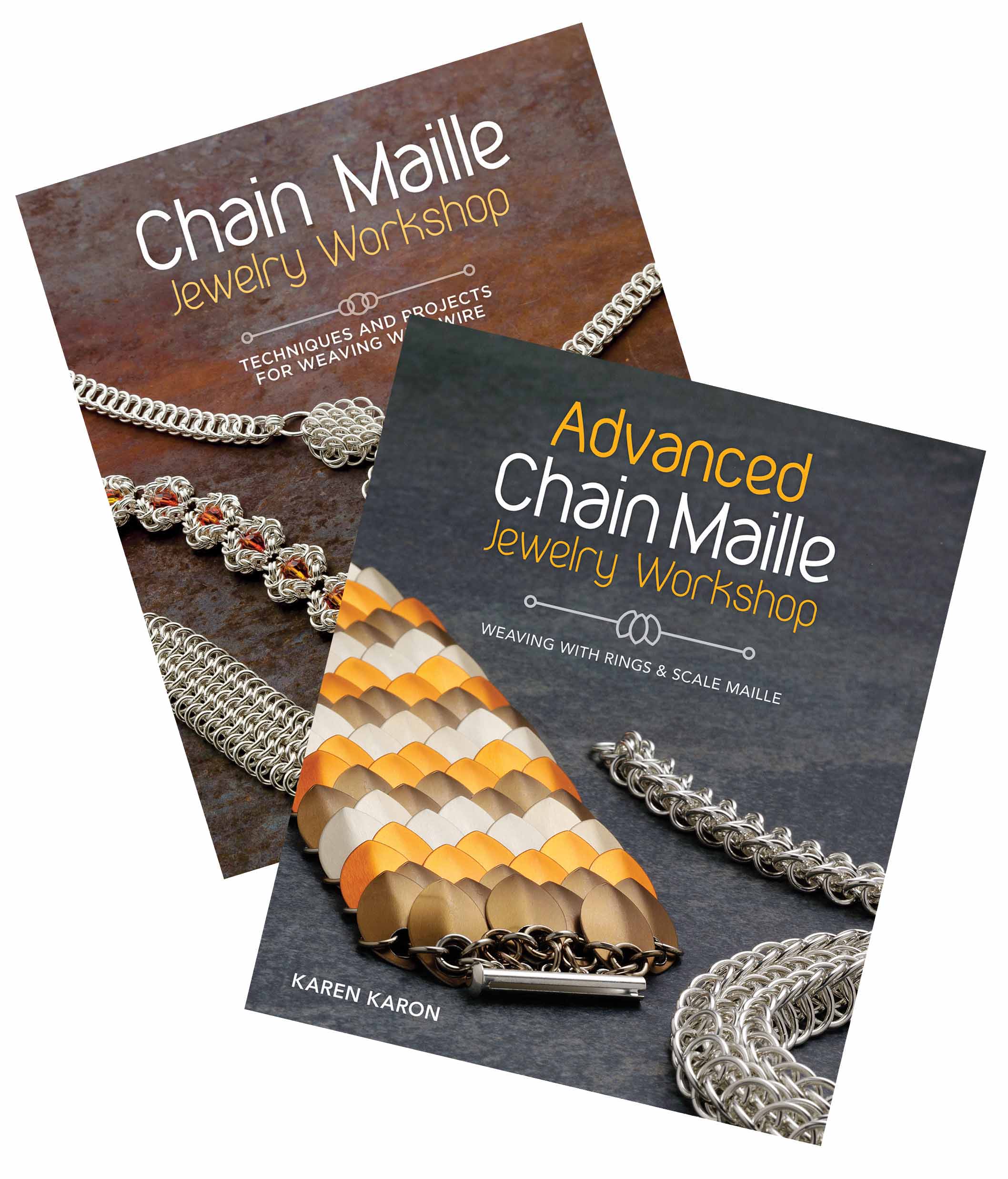 This month, Blue Buddha Boutique is sitting down to chat with Karen Karon of Boston, MA. She hardly needs an introduction, as most of you already know her as author of the best-selling chainmail books Chain Maille Jewelry Workshop: Techniques and Projects for Weaving with Wire and Advanced Chain Maille Jewelry Workshop: Weaving with Rings and Scale Maille.
This month, Blue Buddha Boutique is sitting down to chat with Karen Karon of Boston, MA. She hardly needs an introduction, as most of you already know her as author of the best-selling chainmail books Chain Maille Jewelry Workshop: Techniques and Projects for Weaving with Wire and Advanced Chain Maille Jewelry Workshop: Weaving with Rings and Scale Maille.
Karen’s first book has consistently ranked as the #1 chainmaille book on Amazon for many years. (As a side note, I remember when my book lost its #1 spot to Karen’s book. Honestly, I was (and still am) OK with it, because her book is just THAT GOOD. 😊)
Find out more about designer, author and instructor Karen Karon in this edition of Blue Buddha’s Meet the Artist series. Enjoy getting to know her below!
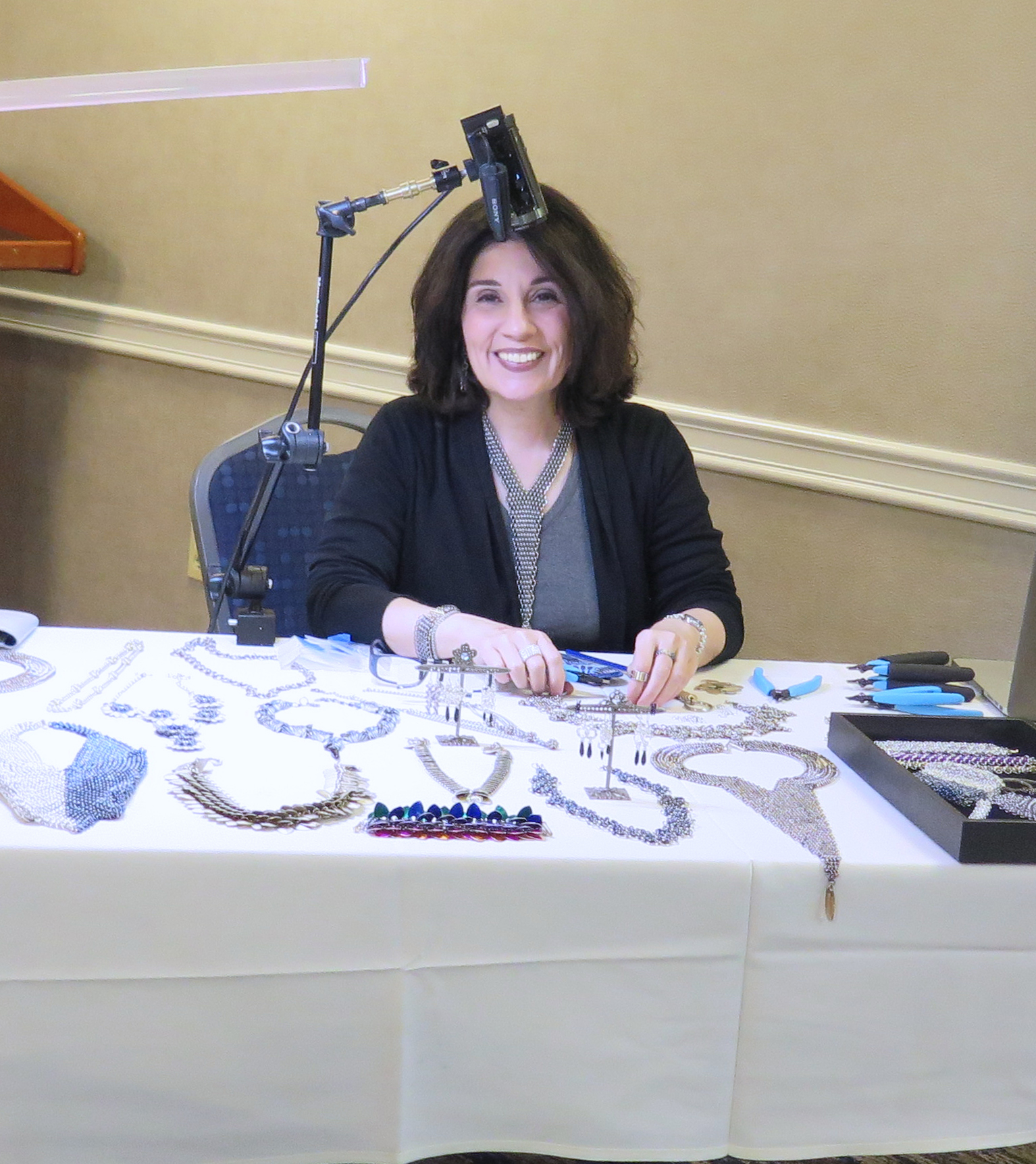
Thanks for taking some time to let us get to know you, Karen! Before we get started, how do you pronounce your last name? I always pronounce it exactly like your first, because it sounds cool…but that might not be right! And is there a story behind the similarities of your first and last name?
Just as you thought, my last name is pronounced exactly the same way as my first name. I married into that name. I like to tell people that I found a husband by looking in the phone book.
How did you get started with chainmaille?
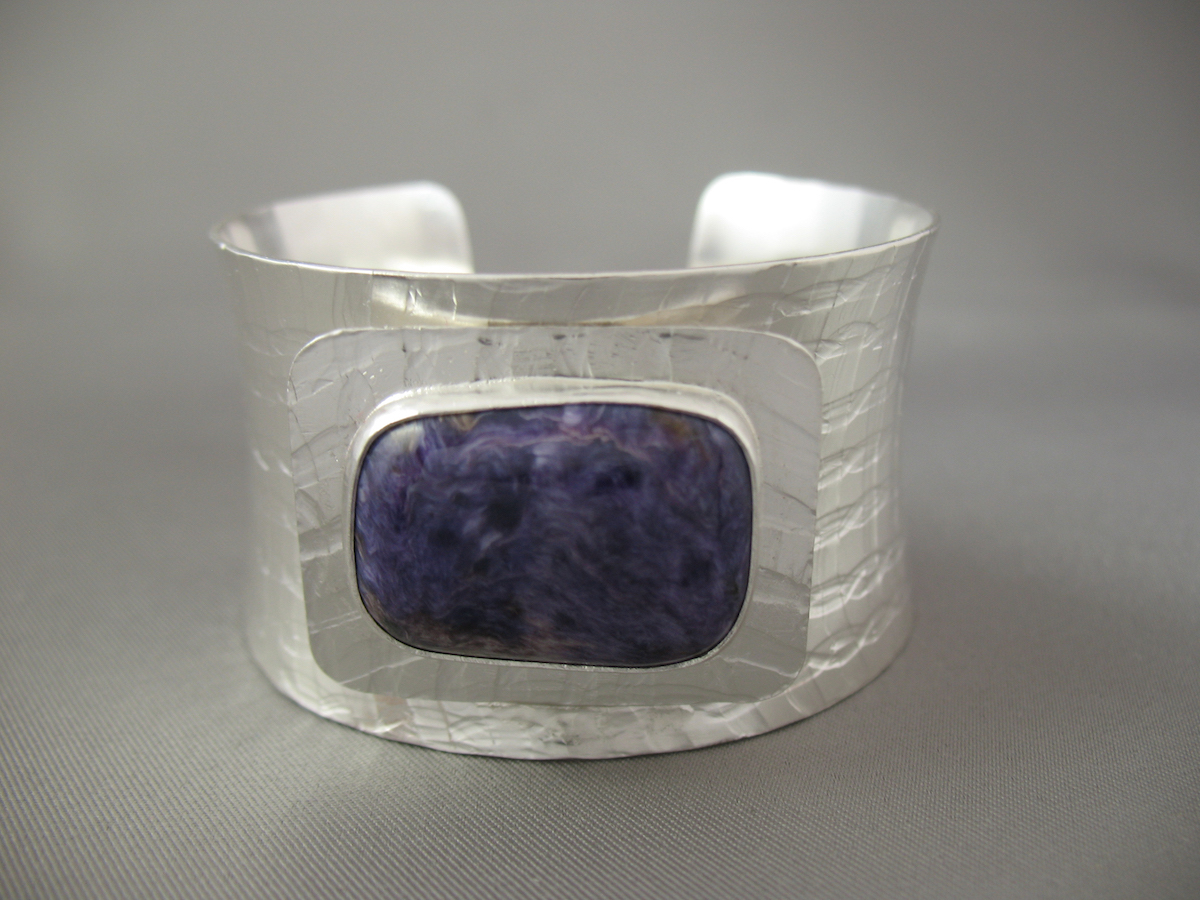 I’m a life long crafter/maker. I’ve tried many different types of crafts over the years. Early in the 2000s, I was in a beading phase. At that time, a local art center advertised a chain making class – not chain maille – woven wire chains similar to Viking knit. I thought that combining chains with beading would be cool, so I enrolled. I found that I really loved working with wire and making chains, so I started to research chain making in books and on-line. That’s how I discovered chain maille. I’ve also explored Etruscan-style fused loop-in-loop chains.
I’m a life long crafter/maker. I’ve tried many different types of crafts over the years. Early in the 2000s, I was in a beading phase. At that time, a local art center advertised a chain making class – not chain maille – woven wire chains similar to Viking knit. I thought that combining chains with beading would be cool, so I enrolled. I found that I really loved working with wire and making chains, so I started to research chain making in books and on-line. That’s how I discovered chain maille. I’ve also explored Etruscan-style fused loop-in-loop chains.
My chain work led me to other metal-related pursuits. I completed the PMC (Precious Metal Clay) Guild’s certification program in 2007. I’ve also had the good fortune to have been able to take many metalsmithing classes taught by some exceptional instructors/artists.
My first chain maille piece was this simple 3-3 chain bracelet.
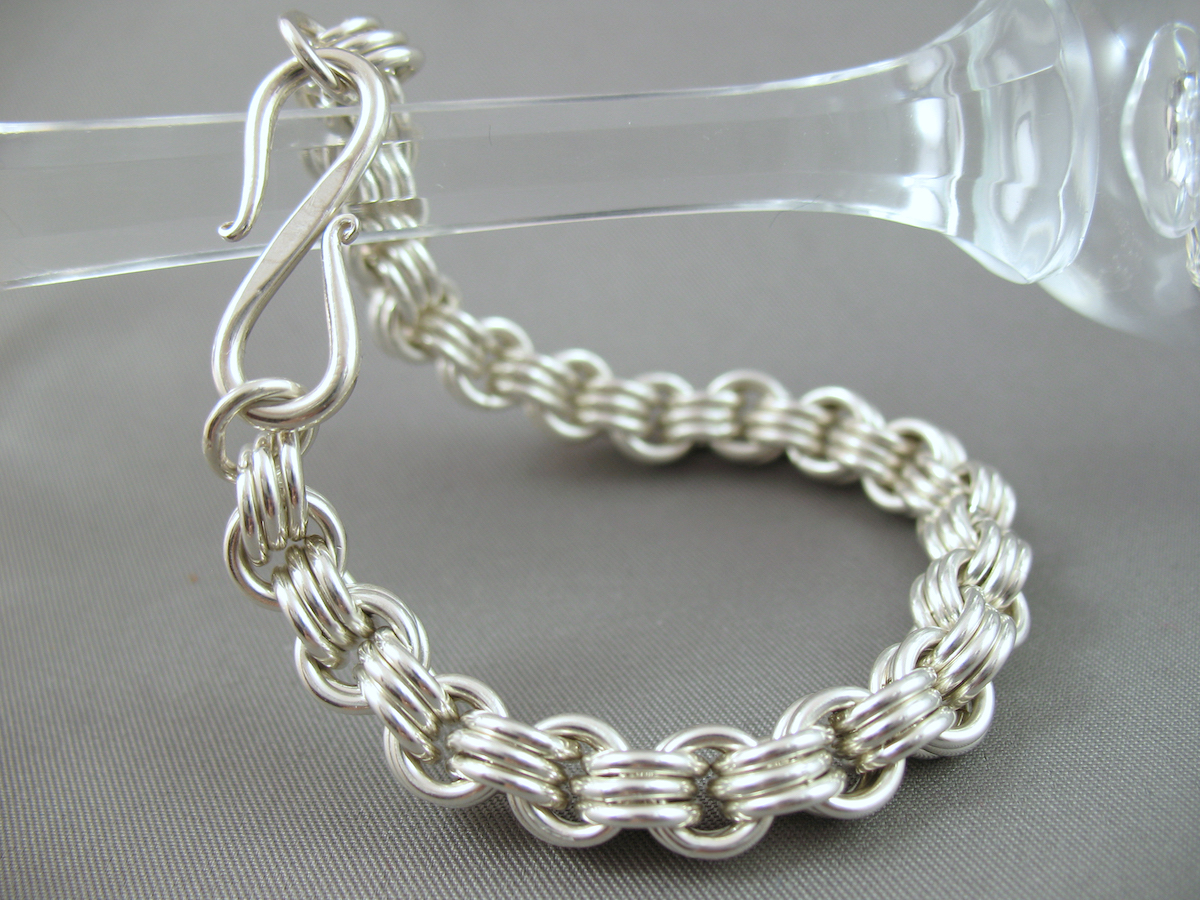
Can you describe your creative process?
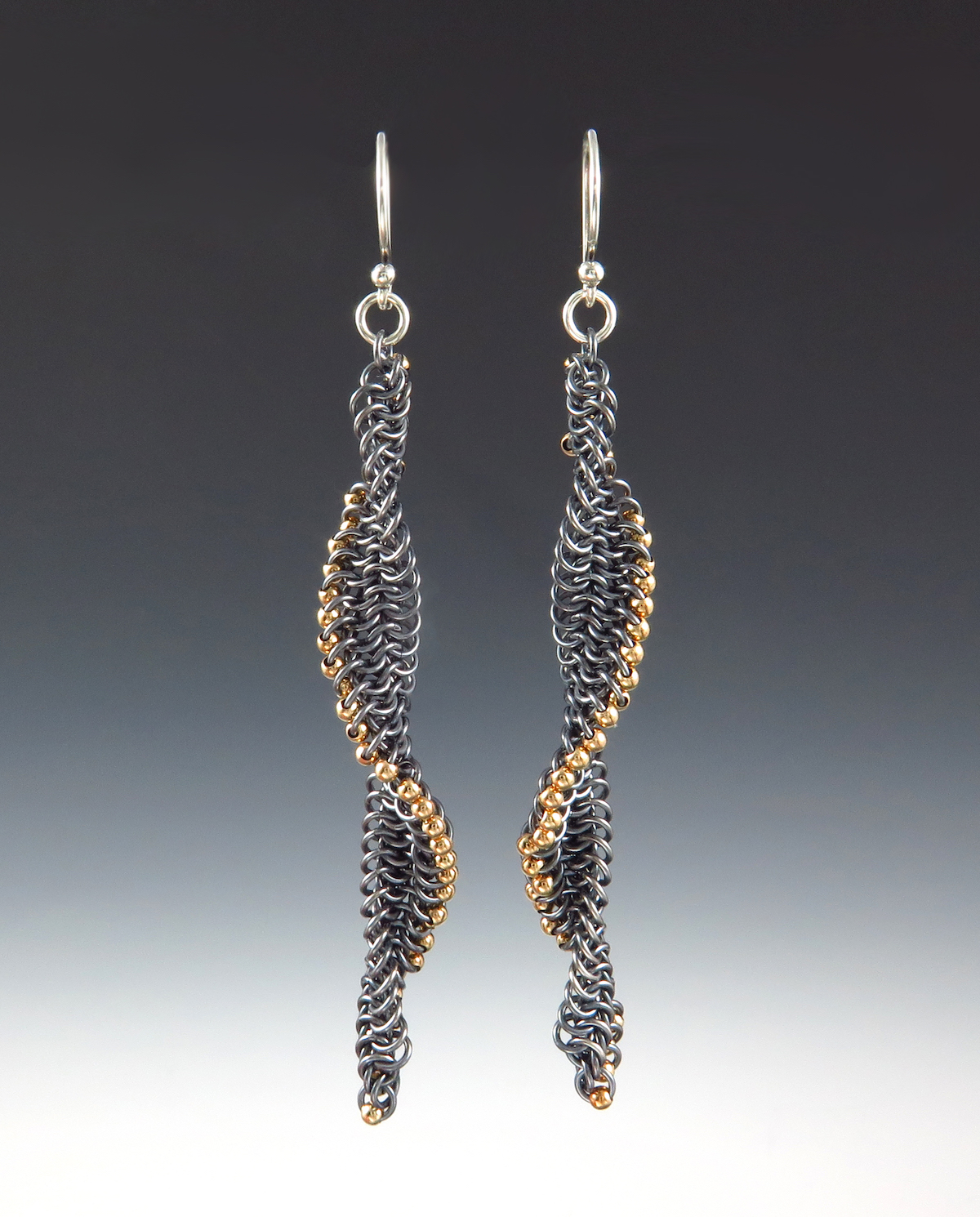 I wish I had a process. Sometimes ideas just come to me – especially when I’m on auto-pilot, like when I’m in the shower or brushing my teeth, or when my mind is wandering, like right before I drift off to sleep. If I can, I’ll write them down on the nearest piece of paper, or paper-like object, I can find. I tried to train myself to use a notebook, but it is not always within reach and I’m not always that disciplined. I’ve got lots of odd scraps of paper and napkins with illegible pen marks floating around. Usually, I just write words describing my idea. Sometimes I TRY to draw it out. Drawing is NOT a talent I possess. Some never get put on paper and just evaporate.
I wish I had a process. Sometimes ideas just come to me – especially when I’m on auto-pilot, like when I’m in the shower or brushing my teeth, or when my mind is wandering, like right before I drift off to sleep. If I can, I’ll write them down on the nearest piece of paper, or paper-like object, I can find. I tried to train myself to use a notebook, but it is not always within reach and I’m not always that disciplined. I’ve got lots of odd scraps of paper and napkins with illegible pen marks floating around. Usually, I just write words describing my idea. Sometimes I TRY to draw it out. Drawing is NOT a talent I possess. Some never get put on paper and just evaporate.
Many people say they are inspired by nature, architecture or fashion. I’m more inspired by shapes and patterns. I notice patterns and shapes everywhere. I hope that makes sense – it’s hard to explain.
I often just start with a hint of an idea in my head. Sometimes, I’ll try a new weave and just start weaving. While I’m working on something, I’ll often turn it around, flip it over, hold it upside down, fold or twist it, and ideas often come from just manipulating a piece.
Other times, I’ll see an old piece in a new way, or see how I can combine an old or unfinished piece with something that I’m currently working on.
I’d like to add, that for each of the successful projects I’ve completed, there are dozens of failures or pieces that are just “not quite right”. I’ve got containers full of UFO’s.
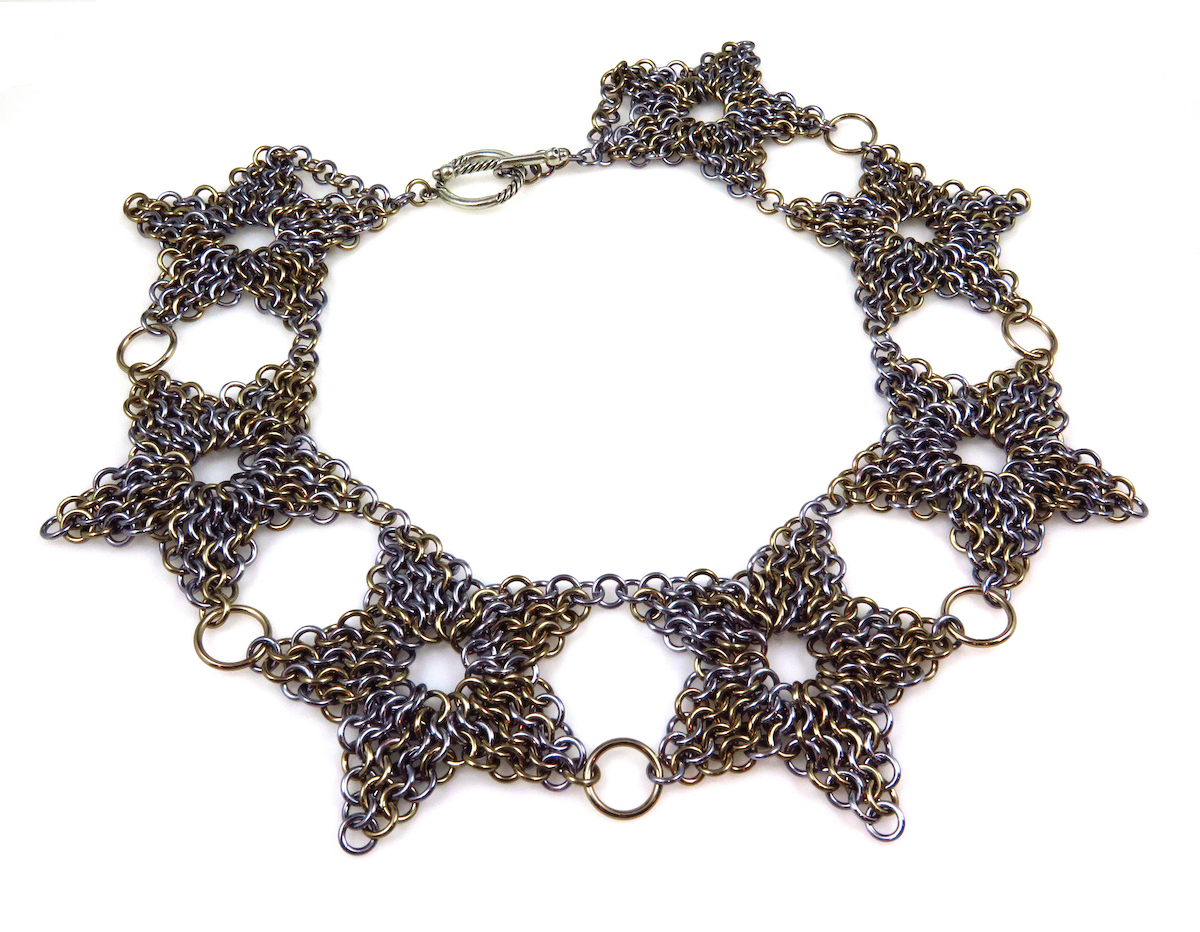
What made you decide to publish your first book?
The “perfect storm” of recession, unemployment and illness. Before the recession, I had a day job, and I taught the occasional chain maille class when I had time off. My students always commented on the quality of my instructional handouts. Many suggested that I get them published, but I had no intention to do so.
Then, the recession hit, and my employer went out of business, leaving me unemployed. During this time, I was also diagnosed with Meniere’s disease – an incurable chronic inner ear condition that produces tinnitus, hearing loss and vertigo (the worst symptom), making it very difficult to hold down a 9 to 5 job. I had to find something I could do on my own terms.
I had all these handouts that I had created, and they had been student-tested. Also, there were not many chain maille books on the market at that time, so I took a shot. What did I have to lose? My manuscript was accepted by the first publisher I sent it to. I was VERY lucky!
Congrats! (I mean, I know it’s pretty late of me to be saying that… but it’s such a great testament to your expertise, artistry and hard work that your proposal was accepted right off the bat!)
What was the hardest part about creating that first book? And what was your favorite part?
I never really set out to write the first book, it just kind of happened. I already had the bulk of the text and photos completed, in the form of class handouts. To turn my handouts into a book, I organized them in a logical progression. Then, I added an opening chapter covering tools and materials, and a concluding chapter covering finishing techniques. I could only work when I was not suffering from vertigo. It took me a few months to finish the writing, and then I had to put together and submit the proposal package. After that, the hardest part was waiting. My favorite part was experiencing the publication process for the first time, even though it was challenging at times.
What was hard and easy about the second book?
The easy part was knowing what to expect. Since I had been through the publication process once before, I knew what my responsibilities would be.
The most difficult part about making the second book was proofing the diagrams. The weaves in the second book are more complicated than the weaves in the first book. The complexity made it more difficult for the illustrator to create the diagrams and for me to review them. I had to follow each ring in every diagram with my eyes, ensuring that the “unders” and “overs” were correct – many, many hours of very tedious work.
Having published a few books, what would you say are the benefits? And drawbacks?
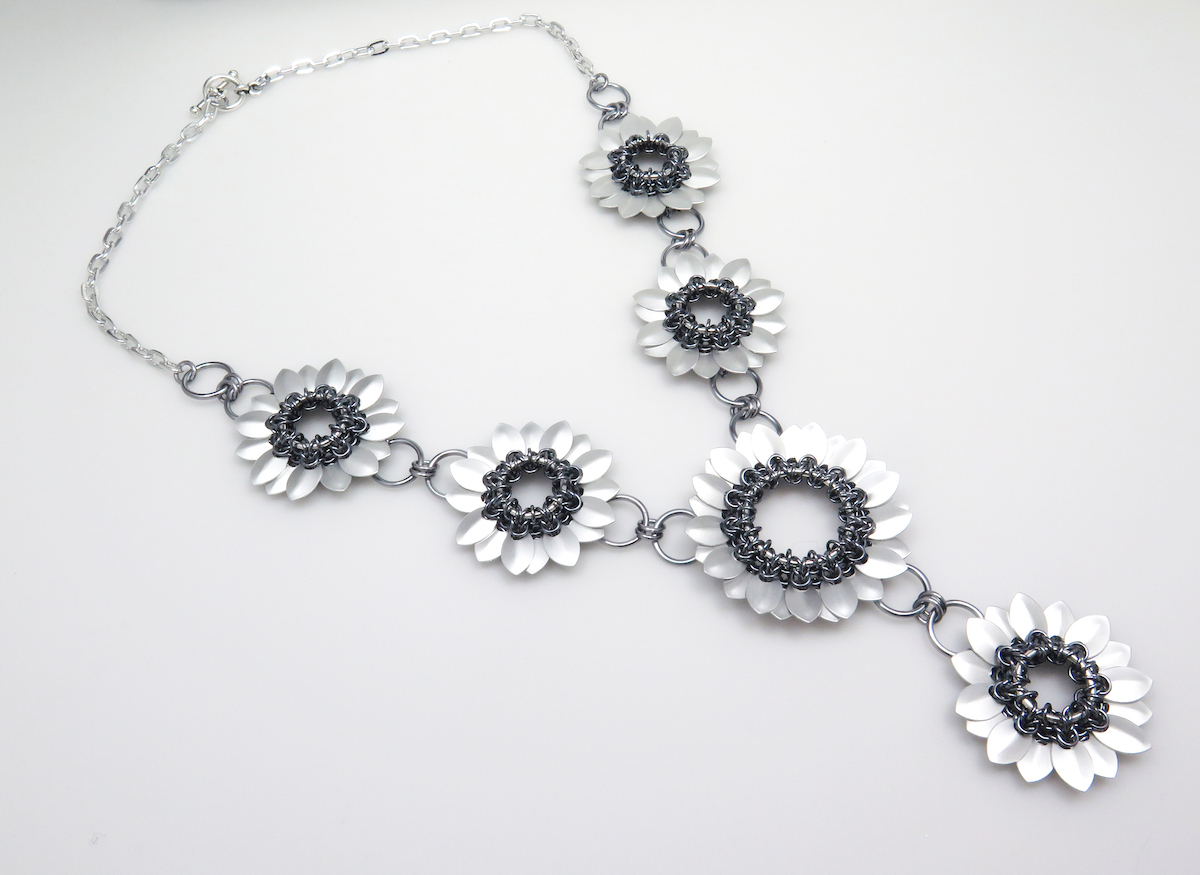 In short, if you’re looking for fame and fortune, you’ll be disappointed! 😊 I’d like to say that I am grateful to have had the opportunity to publish two books. It was challenging, but also rewarding. The pros are mostly intangible – like the sense of personal accomplishment you get from being a published author and the boost to your professional reputation provided by the publication of your work. The process of writing and working with an editor was a valuable experience that pushed me to improve, both as an author and as an artist. And, it’s fun to see my books in a book store or library!
In short, if you’re looking for fame and fortune, you’ll be disappointed! 😊 I’d like to say that I am grateful to have had the opportunity to publish two books. It was challenging, but also rewarding. The pros are mostly intangible – like the sense of personal accomplishment you get from being a published author and the boost to your professional reputation provided by the publication of your work. The process of writing and working with an editor was a valuable experience that pushed me to improve, both as an author and as an artist. And, it’s fun to see my books in a book store or library!
The pros and cons of working with a publisher are:
Pro: They have a team of professionals; editors, photographers, illustrators, layout designers, etc. that make your work look attractive and professional.
Pro: They have a network of industry contacts that will get your book in stores and out to the appropriate audience.
Con: The publisher has a lot of say regarding the look and content of your book: whether to use diagrams or photos, the lay out, the fonts, the cover design and title, the length, the price, the date of publication, what stays in and what gets cut. They will listen to your opinion, but ultimately, they make the final decision. So, you have to be OK with giving up some of your control over the material.
Here’s a link to an article I stumbled across a few years ago called Is It Worth It to Write a Craft Book? I bookmarked it because I thought it provided a realistic description of some of the issues involved in publishing a craft book in the internet age.
Of course, the question everyone wants to know: When will your next book be published?
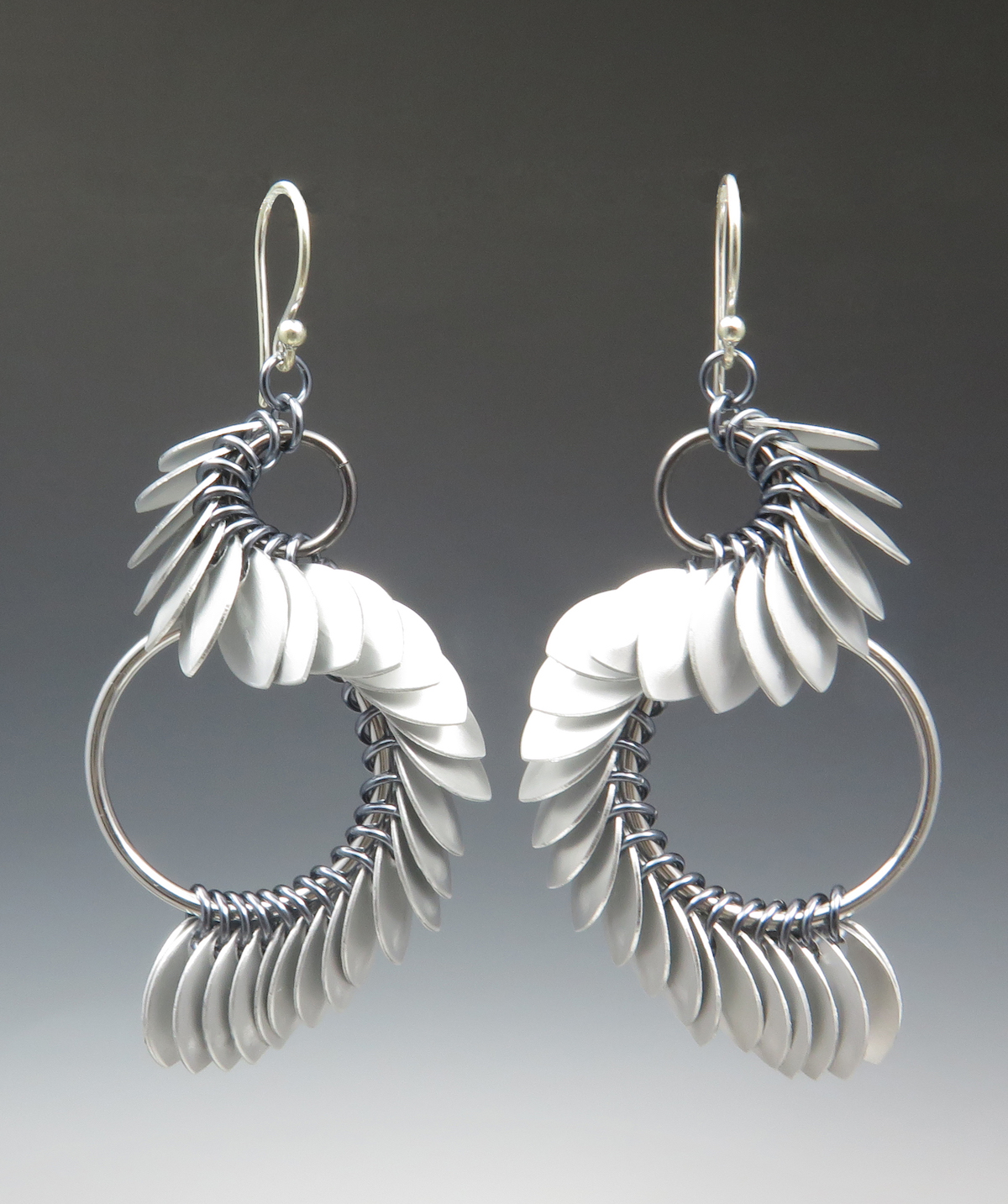 I don’t know if I’ll do another one. Shortly after the second book was released, I completed a third book that focused on using Tiny Scales. I shopped it around to a few publishers, but the consensus was that the subject matter was too niche. So, after sitting on the material for several months while searching for a publisher, I decided to break up the book into individual projects and offer them as separate tutorials on my website.
I don’t know if I’ll do another one. Shortly after the second book was released, I completed a third book that focused on using Tiny Scales. I shopped it around to a few publishers, but the consensus was that the subject matter was too niche. So, after sitting on the material for several months while searching for a publisher, I decided to break up the book into individual projects and offer them as separate tutorials on my website.
I’ve recently begun to make some chain maille tutorials available as well. So far, a few Dragonscale projects and Hoodoo Hex Earrings – I plan to add more.
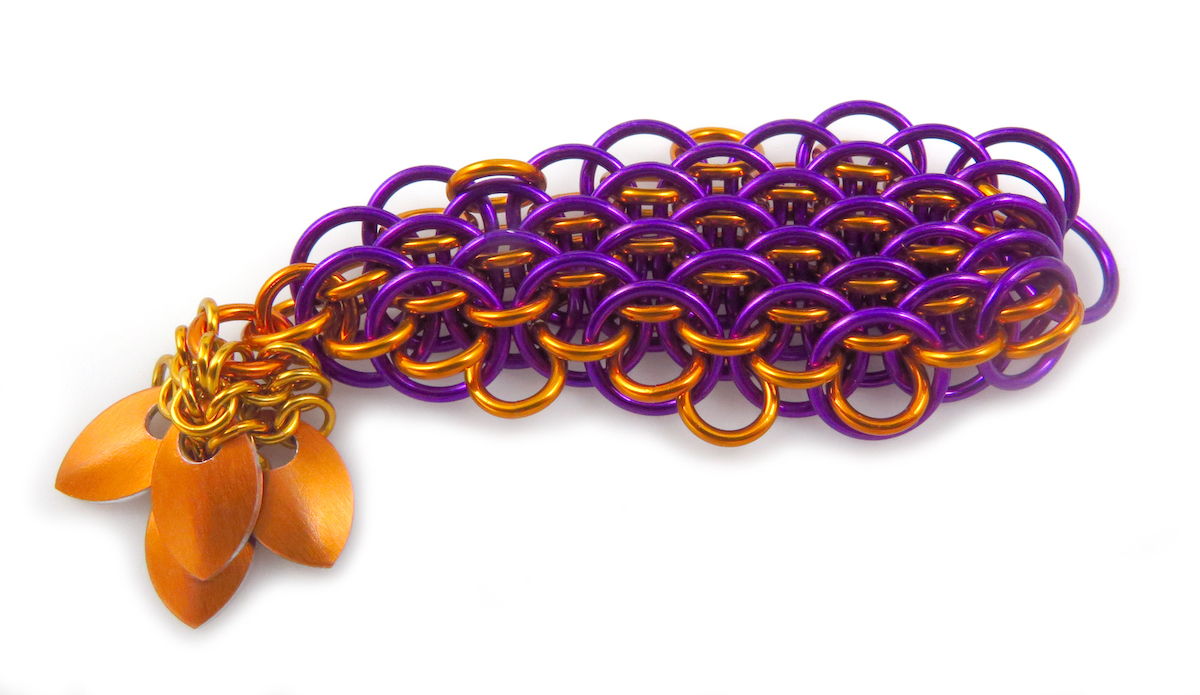 I find that I like the ability to release material at my discretion. When writing a book or a magazine article, the publisher expects the writer to keep things under wraps until publication. It’s difficult to resist the urge to post pictures of new projects that I’m excited about on my website or social media because I’m waiting for the publication date to arrive (which can be a year or more from the creation of the project). I also like having total control of my content.
I find that I like the ability to release material at my discretion. When writing a book or a magazine article, the publisher expects the writer to keep things under wraps until publication. It’s difficult to resist the urge to post pictures of new projects that I’m excited about on my website or social media because I’m waiting for the publication date to arrive (which can be a year or more from the creation of the project). I also like having total control of my content.
Having published both a book and stand-alone tutorials, I must say that I agree with ALL of what you just said!
What is/are your current goal(s)?
Just to stay healthy and keep on weaving.
What’s your favorite piece that you’ve created?
My favorite piece is always the newest one. Here’s my newest – the Mermaid Necklace.

What is one tool that you cannot live without?
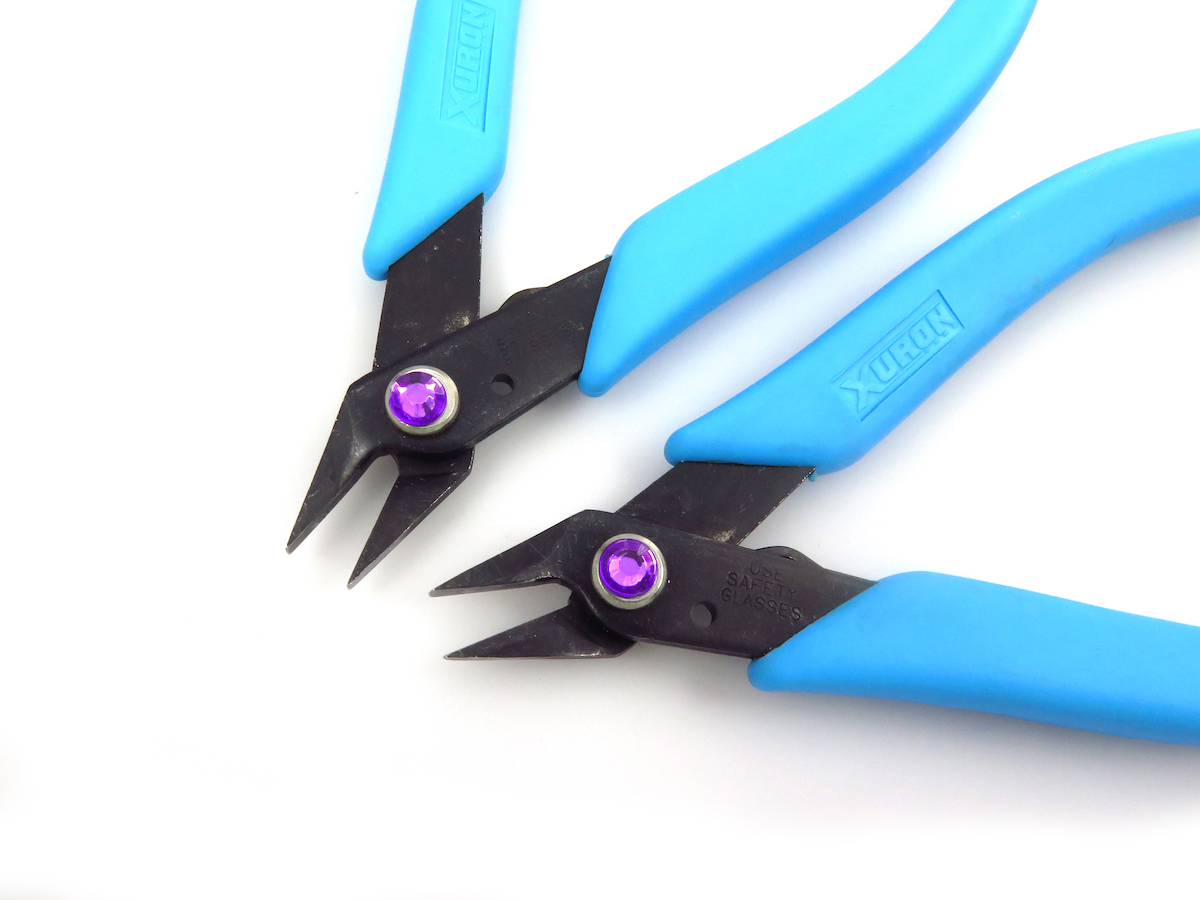 I guess that would be my pliers. I’ve got lots!!!! Lately, I find myself most frequently reaching for my set of Xuron 483 short, wide, flat-nose pliers. I’ve slightly modified the jaws, making them thinner (not narrower), so they are just right for most of my needs. Some of my students have done the same. If you want to know more, check out my blog post: How I Modify My Plier Jaws.
I guess that would be my pliers. I’ve got lots!!!! Lately, I find myself most frequently reaching for my set of Xuron 483 short, wide, flat-nose pliers. I’ve slightly modified the jaws, making them thinner (not narrower), so they are just right for most of my needs. Some of my students have done the same. If you want to know more, check out my blog post: How I Modify My Plier Jaws.
I’ve also applied adhesive “jewels” to mine so my students don’t accidentally walk off with them (which happens from time to time, because our pliers all look the same).
OMG, I love the bejeweled pliers!
So, when I did a call for questions on FB for this post, in addition to several questions already asked, you received two VERY specific questions from the audience! They know you well. 😉
1 – Do you plan on or have done a hoodoo hex tut or a moorish rose tut?
I recently added a Hoodoo Hex Earring tutorial to my website. I’ll leave the Moorish Rose to Lisa Ellis!
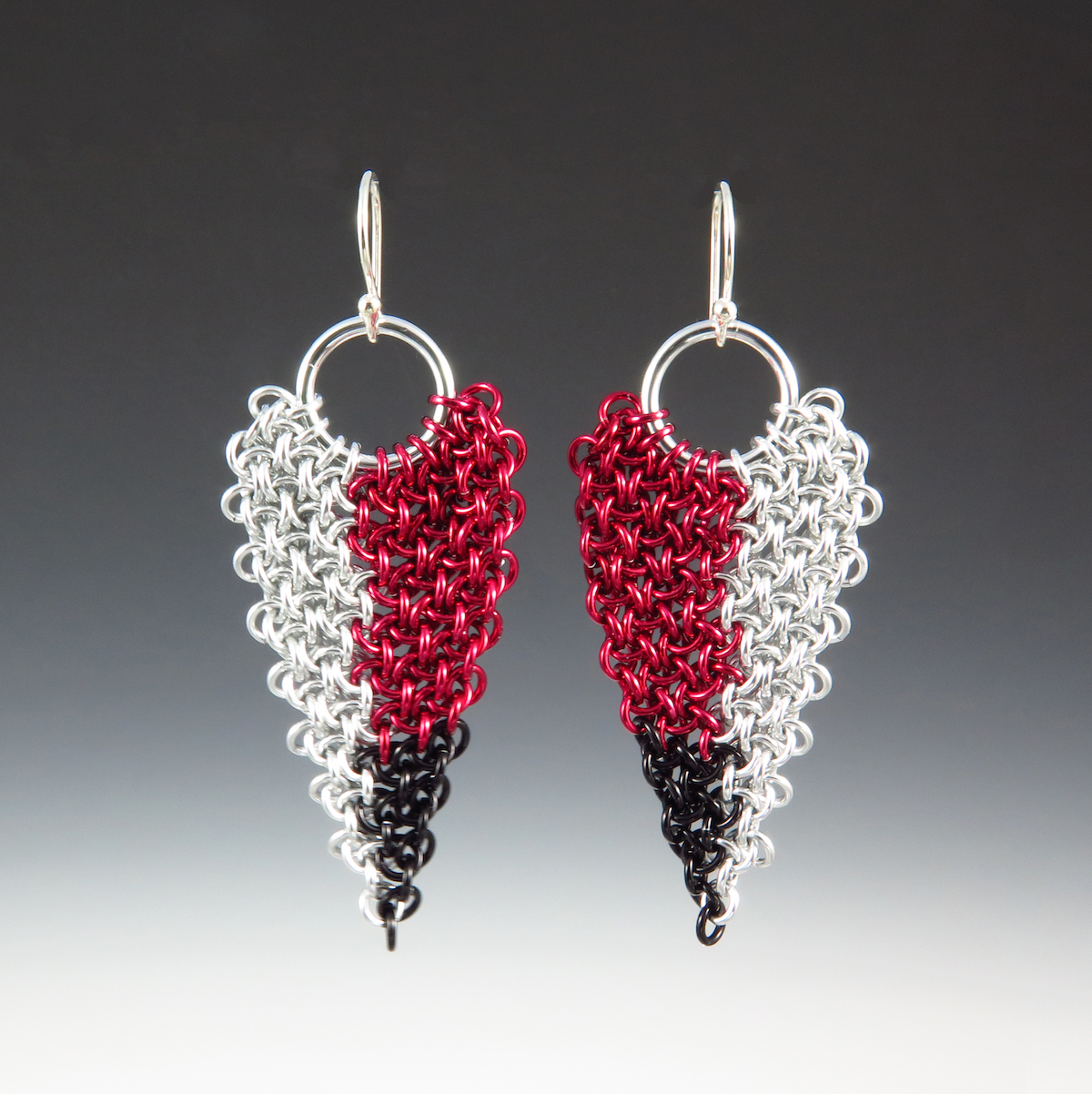
Haha, fair enough. To me, Lisa is Queen of Moorish Rose!
2 – How do I improve my closures? I’m already better than I used to be. Do you have suggestions on how to get even better?
Practice, practice, practice! That said, it is difficult to diagnose what your exact issue might be without seeing how you work. Here are some things to keep in mind:
- The right tools are important. I like flat nose pliers best because I feel the amount of surface contact they provide gives me greater control. Use armorer’s style pliers when weaving with large rings, thick gauges or stiff metals. Use smaller jawed pliers (I like Xuron 475 short flat nose or Xuron chisel nose pliers) when weaving with small jump rings. Make sure the handle length and shape feel comfortable in your hands, and that the spring is not too springy.
- Brace your arms on your work surface when weaving to keep steady – no “air weaving”.
- Support your work so that the full weight of the piece is not working against you.
- Remember to use good form – pliers placed at approximately 10 and 2 o’clock positions, inside surface of jaws parallel to the surface of the jump ring and apply inward pressure evenly to close the kerf (ends should overlap). For difficult to close rings, applying inward pressure when opening can be beneficial. Don’t pull, push or roll your wrists. The “death grip” is not helpful. Try choking up a bit on the pliers.
- Always check each ring, vertically and horizontally, to ensure it looks good before moving on to the next. I usually run my finger over each closure as well, to catch what my eyes might have missed.
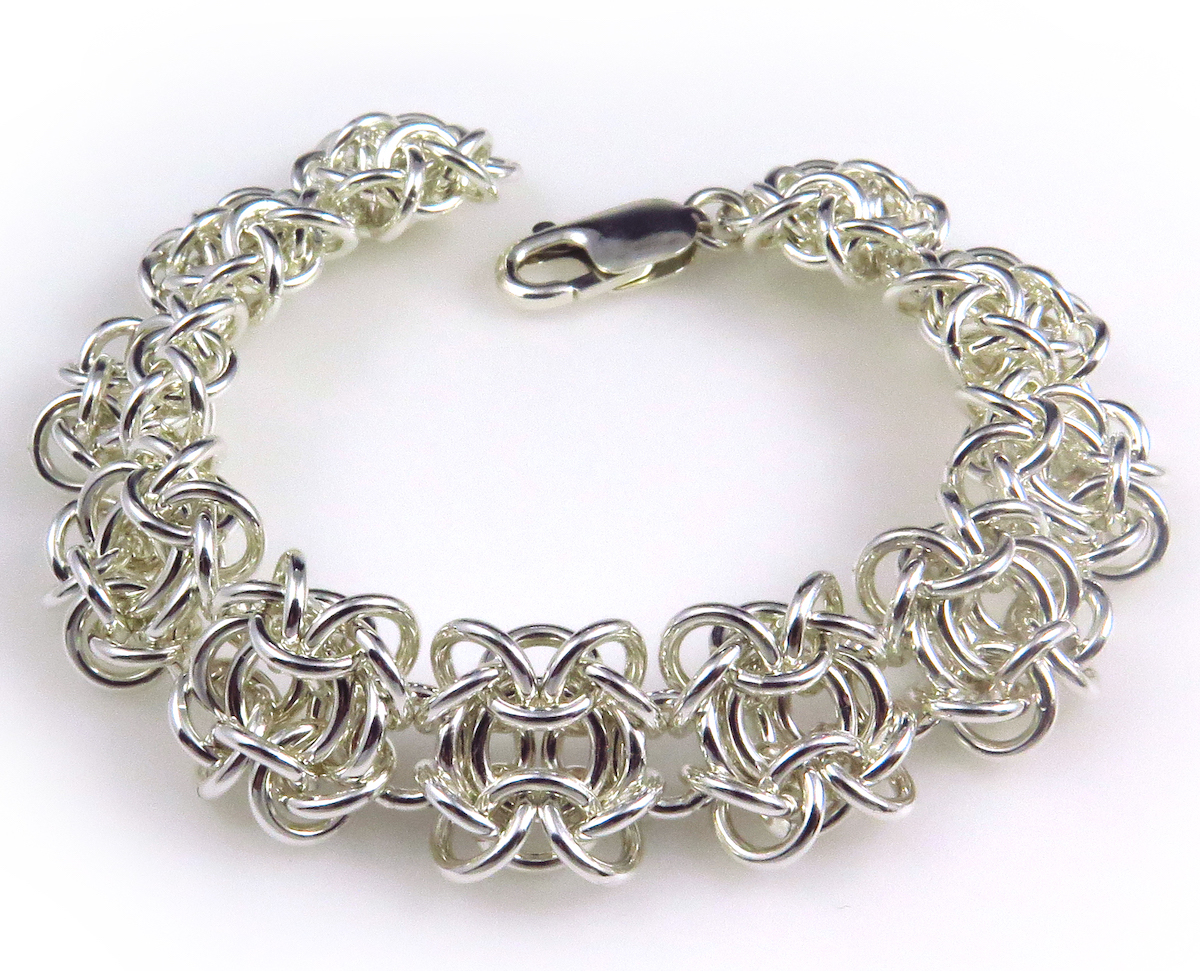
OK, Onto the quick questions that I ask all participating artists:
Do you listen to music/podcasts/tv/etc while mailling? If so, what are your favorites?
Sometimes I watch TV, sometimes I listen to music, and sometimes my husband reads to me (usually articles from the Boston Globe about the Red Sox). If I have the TV on while I’m weaving, it’s usually something that I don’t really need to look at (re-runs, news, favorite old movies). It’s just on for background noise, which takes my mind off my tinnitus. My favorite music will date me – Bruce Springsteen, Tom Petty, Beatles.
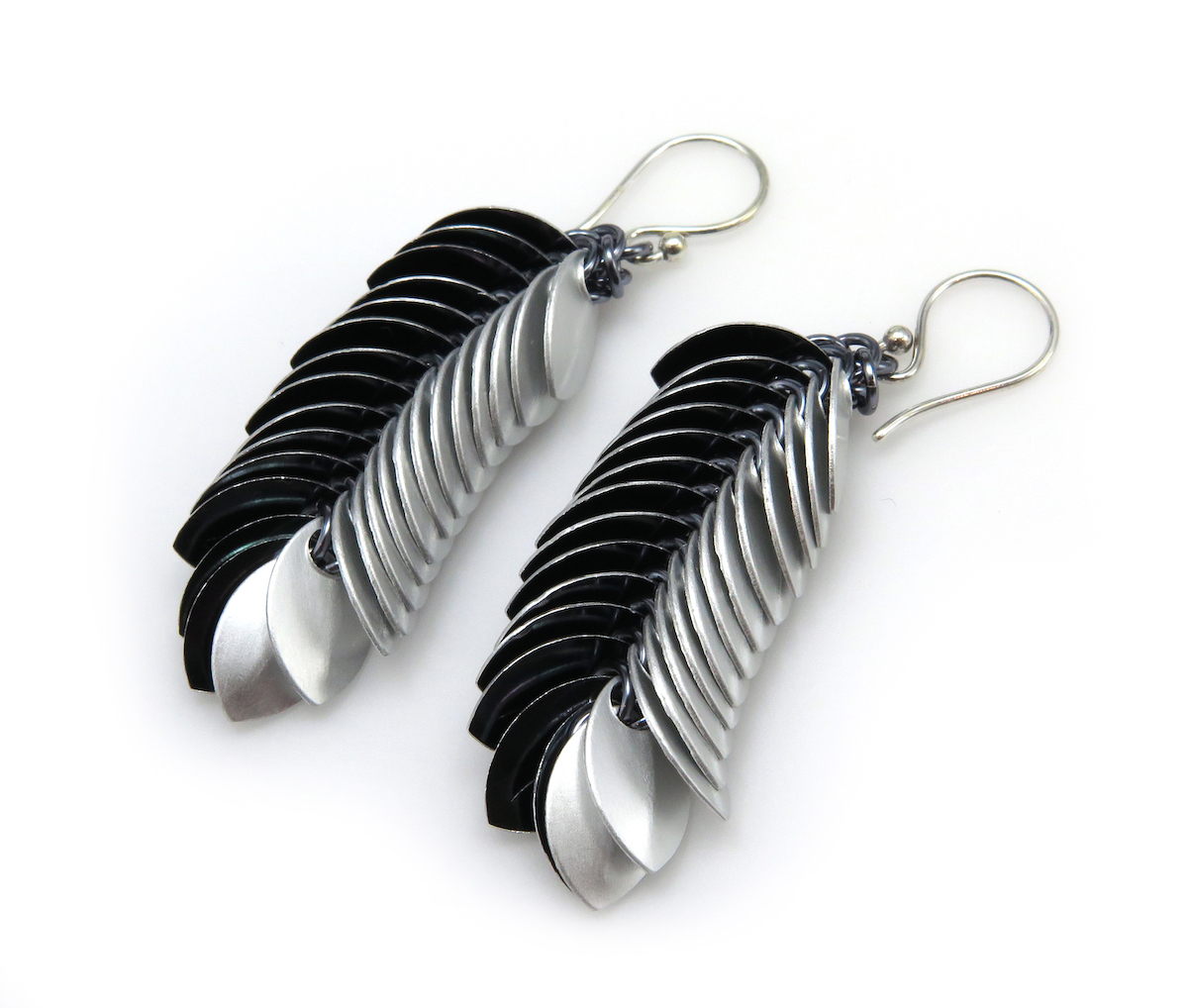
What are your favorite artists (chainmaille or otherwise)?
I’ve got a very long list of chainmaille artists whose work I admire. I’ll begin with you, Rebeca Mojica. Your book, Chained, was one of the first chain maille books I bought! Here are just a few more names that come to mind: Lisa Ellis Joshua Diliberto, FeMailler, Corvus, ItIsKnown, Scalesmythe (Forge & Fleece), Spider, Brilliant Twisted Skulls, Rapt in Maille, Steam Punk Garage, Hanibal King, Stephen Hoffman, Tony Moeller, Brigitte Chainmaille, Zili, Chainmailbasket, Hyperlynks, Dawdling Dragons, 202east, Punklette Originals, Kristina Griffin, Asia Azran OIH Design…
[Editor’s Note: Some of these artists have been featured in our Meet the Artist series, and you can read those interviews here: Lisa Ellis , Joshua Diliberto, ItIsKnown, Tony Moeller and Spider.)
What do you do when you’re not making chainmaille?
I’m either knitting or crocheting! I find a lot of similarities between knitting/crocheting and chain maille.
What would your superpower be and why?
Teleportation, because I love to visit new places, but my inner ear condition makes travel difficult. 😄
What’s one thing Blue Buddha readers might be surprised to know about you?
The thing about me that usually surprises most people is that I make chain maille for a living, but you already know that!
Before we let you go, please tell us where we can find your work!
- My jewelry can be found here: https://alchemy925.com/
- My classes can be found here: https://metalwerx.com/
- My tutorials can be found here: http://karenkaron.com/tutorialshop/index.html
- My website can be found here: http://karenkaron.com/index.html
- My blog can be found here: http://karenkaron.com/blog/
- Find me on Facebook: @karenkaronauthor
- Find me on Instagram: @karenkaron
Best way to contact me – email: [email protected]
My books Chain Maille Jewelry Workshop and Advanced Chain Maille Jewelry Workshop can be found where ever you like to buy your books.- This was fun!!! Thanks, Rebeca!
Thanks so much for taking the time to chat with us, Karen! I really enjoyed learning about how you got started and your experiences writing your books!
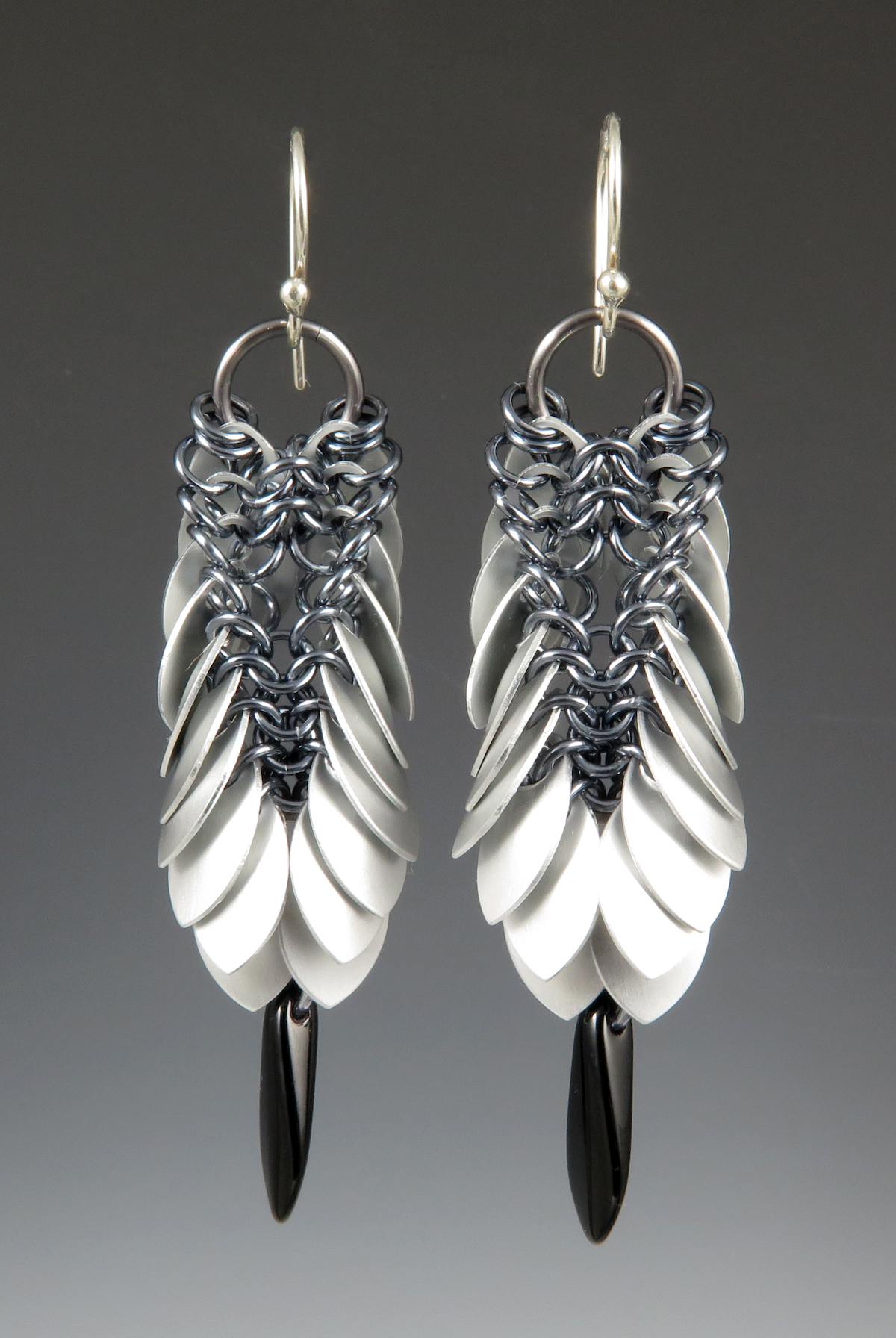
And thank you, readers and fans of this series. While you’re here, be sure to check out the previous “Meet an Artist” posts: http://www.bluebuddhaboutique.com/blog/category/ask-an-artist-series/ and let me know if there’s anyone you want to see interviewed and any questions you have for them. ‘Til next time, happy crafting!

Karen is an outstanding instructor and a really wonderful person. I have been lucky that I live in the Boston area and have taken many of Karen’s workshops, including Hoodoo Hex, coming up next week at MetalWerx. I’ve learned so much from her and look forward to even more opportunities to do so in the future. Karen Karon rocks!